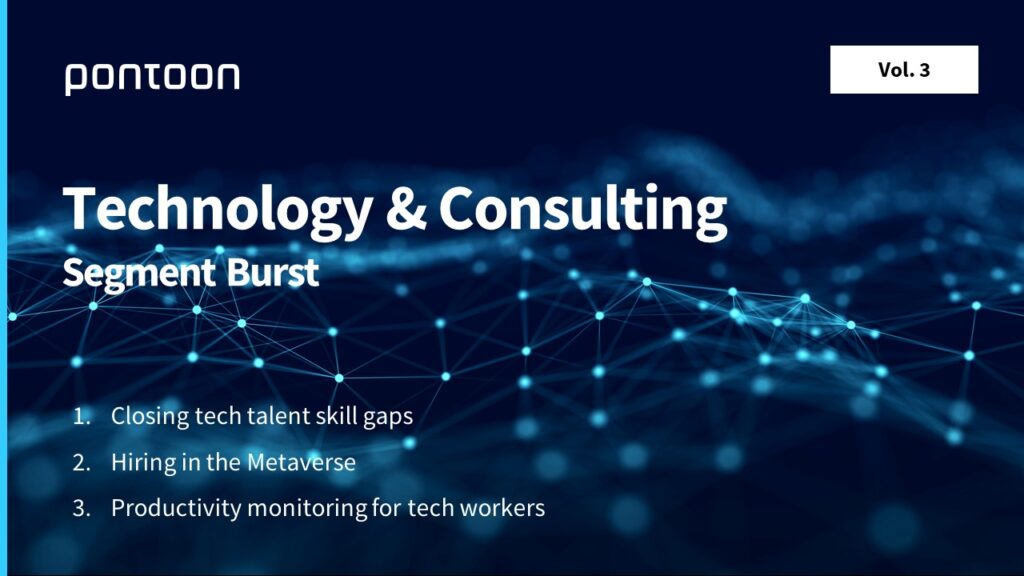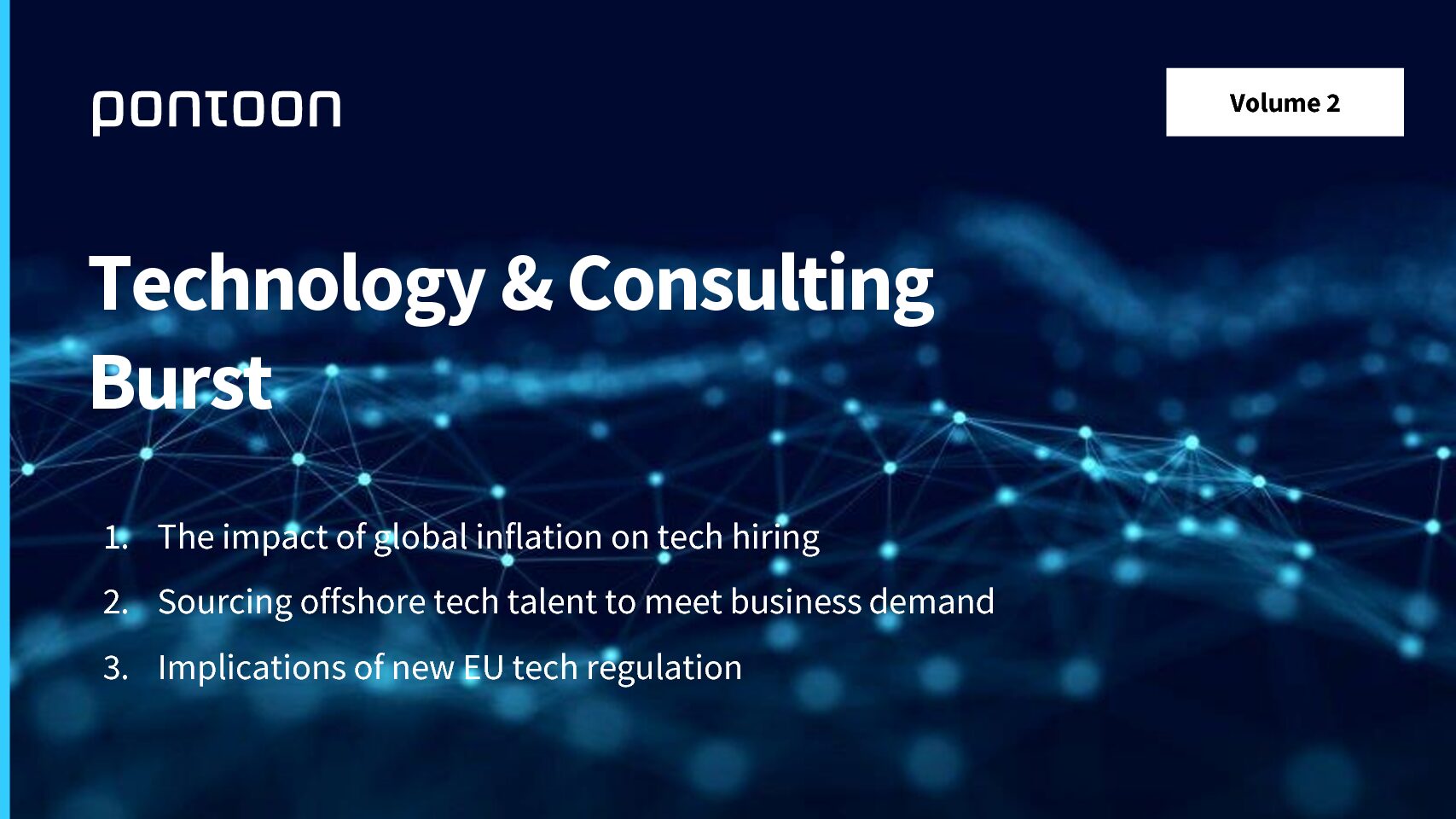Technology & Consulting Segment Burst: Vol 3
Research
.
In the third volume of Technology and Consulting Segment Burst we explore the most recent trends in the sector.
-
What are the critical elements in closing tech talent skills gaps?
-
How Metaverse is changing the way organisations think about hiring?
-
Tips to improve worker engagement without the use of monitoring technology
Closing tech talent skills gaps
The IT skills gap is growing. Industry leaders recognise the need to constantly evolve skills to stay competitive is a significant challenge. Workers are primed and ready to develop their skills to close these gaps despite changing business needs. While some niche profiles are essential to business growth, other roles are becoming obsolete.
Tech upskilling and reskilling must be prioritised to keep up with demand. According to McKinsey, only 58% of organisations currently analyse their skills gaps, with evaluations rarely confirming worker competencies. 50% of employees state that their employer doesn’t understand their capabilities, and only 44% of workers believe their organisation is prepared to deal with role disruptions.
Organisations can avoid skill disruptions by performing skill gap analyses for tech roles. A clear view of what skills are missing in the cloud technology space is crucial, as companies often underestimate the skills they need.
This analysis can be supported by team-level workshops, certification courses, and internal competitions that create a culture of learning and skills development. Keeping up with innovation and organisational demand requires strategic workforce planning to ensure the right talent is hired.
Knowing where to start with a gap analysis can be challenging. Here are some fundamental elements to include in your organisation’s analysis:
- Define skills for critical roles
- Track trends to identify future skill requirements
- Review current worker skill sets in detail
- Use data to explore and implement upskilling and reskilling programmes
- Establish skill gap analysis protocols as standard practice
Hiring in the Metaverse
The Metaverse has been trending for some time, but the virtual world in which people work and interact with others is still quite conceptual.
Research from PwC says 66% of companies are actively engaged in Metaverse, experimenting with techs like AR, AI, and mixed reality worlds to hire remote workers and improve onboarding in a virtual environment. According to SHRM, 82% of executives expect Metaverse plans to be part of their business activities in the next three years.
How seriously are companies investing in Metaverse? In a survey from PwC, 32% plan to hire a “Metaverse leader,” responsible for staying apprised of any new technology brought to market and the tech’s impact on user experience. 51% already have designated roles focusing on the virtual world.
Leaders continue to consider investment in Metaverse technologies and are looking for tech talent to develop new projects.
L’Oréal and French business school HEC Paris partnered with big tech to launch a startup acceleration programme dedicated to innovation and job creation in the Metaverse.
Organisations that want to leverage Metaverse need to focus on the digital skills needed to play in the space. Hiring candidates with transferrable skills is an important place to start, and upskilling current workers to take on new initiatives and roles in this space while focusing on data security will accelerate project goals.
Forward-thinking business leaders should foster digital trust in the future of Metaverse and embed virtual environment learning in their organisation’s digital transformation strategy.
Productivity monitoring for tech workers
Remote work has introduced many benefits to organisations and workers, but productivity and engagement questions have been raised. With the buzz of the Great Resignation and quiet quitting, some leaders are worried about how workers spend their time during work hours. New ways to track employee productivity in a virtual environment are becoming more common. Research shows that 80% of the ten largest private US companies track individual worker productivity metrics.
A recent meta-analysis from ScienceDirect found that being monitored electronically actually reduces job satisfaction and increases stress levels. As employers look for ways to hold their tech workforce accountable, many may need to reconsider productivity-tracking apps as a solution for worker disengagement.
Organisations may be justified in tackling productivity issues, but transparency is key to keeping workers engaged and productive. If employers decide to monitor worker activity, they must explain the scope and purpose of their actions. This can reduce the damage to worker morale and increase employee acceptance of surveillance measures by about 70%.
Secretly monitoring tech workers will not boost their productivity. It can create divisions between managers and their teams and may be interpreted as micromanaging. A lack of transparency can negatively affect employee morale and ultimately damage talent retention – something employers must avoid in today’s competitive job market.
Employers must also self-reflect on their approach to productivity and engagement to verify whether the work environment and culture support employee productivity.
To avoid any negative fallout from monitoring computer activity, here are a few alternative ways to build trust and improve engagement without monitoring software.
- Create a work culture that includes psychological safety
- Lead with empathy and trust
- Focus on collective problem-solving and ask for feedback
- Understand the unique challenges of local teams
Related Post
How is global inflation impacting hiring tech talent?
Why is sourcing offshore a popular option for many organisations, and where to find the tech talent?
How are the new EU tech regulations ...





